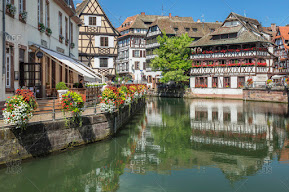Far
We've been travelling far
Without a home
But not without a star
America, Neil Diamond
With so many family names coming out of France, I thought it’d be a good idea to get acquainted with those areas and why our families may have left. Here’s a “tour de France” starting in Bordeaux with maps courtesy of Google Maps:
Biane (Lailhengue) - possibly Bordeaux, Gironde, Nouvelle-Aquitaine, 1860. Possible Reason: New Orleans was a main destination for those looking for a Francophone environment. The French in New Orleans surely read the French newspaper, The New Orleans Bee (L’Abeille de La Nouvelle Orléans), published from 1827-1923.
Cutrer - possibly modern-day Meschers-sur-Gironde, Saintonge Estuaire, Charente-Maritime, Nouvelle-Aquitaine, 1688 to England. Reason: Religious Persecution of Huguenots
Now on to Paris and the Ile de France:
Lailhengue and Lassalle - Paris, Ile-de-France, 1882. I’m not convinced they were actually from Paris. Possible Reason: in 1871, Lailhengue would’ve been age 27 (old enough to fight) and Lassalle age 7. Paris was beseiged by Germans for 4 months until France surrendered. They would have survived starvation and illness. Afterward, French radicals briefly took over Paris ending in a battle that left 10,000 Parisians dead and much of the city destroyed. Picture above:
The Lower Market by Victor Gabriel Gilbert (1881)
Now on to Alsace after a 12-hour drive:
Mercier (Lailhengue) - Grandvillars, Belfort, Alsace (modern-day Bourgogne-Franche-Comte), 1872, and Thomas (Lailhengue) - Boron, Belfort, Alsace (modern-day Bourgogne-Franche-Comte), 1872. Possible Reason: From Wiki “…after the loss to Germany of most of Alsace in 1871, the Belfort population was boosted by the arrival of large numbers of refugees from "Germanisation": the years between 1871 and 1914 saw the development of large factories, with the mechanical and textile sectors being prominent growth areas. The population increase and the economic development were at their most intense in the Belfort conglomeration itself.”
 Meyer (Lailhengue) - Altkirch, Haut-Rhin, Alsace (modern-day Grand Est), possibly 1867. Possible Reason: Uneasy about the possibility of being given back to Germany (which happened in 1871)
Meyer (Lailhengue) - Altkirch, Haut-Rhin, Alsace (modern-day Grand Est), possibly 1867. Possible Reason: Uneasy about the possibility of being given back to Germany (which happened in 1871)Picture at left: Altkirch, Photo by Juergen Ehret on Wikipedia.org
Guice (Rockett) - Strasbourg, Bas-Rhin, Alsace (modern-day Grand Est), 1740. Reason: Palatinate with the promise of free land and free passage.
Picture above: Strasbourg by Offset at Shutterstock.com
The Alsace-Lorraine and Territoire de Belfort areas are special. Whenever I see a census mention a birthplace in Germany, but others are born in France, I immediately suspect Alsace-Lorraine is involved somehow. Here's a map showing the "departements" of the region:
Historic Lorraine (modern-day region Grand Est):
Meuse (Dept. 55)
Lorraine Regional Natural Park - spans 3 Departements: Meuse, Meurthe-et-Moselle and Moselle
Meurthe-et-Moselle (Dept. 54)
Moselle (Dept. 57)
Vosges (Dept. 88)
Historic Alsace:
Bas-Rhin (Dept. 67) modern-day region Grand Est
Haut-Rhin (Dept. 68) modern-day region Grand Est
Territoire-de-Belfort (Dept. 90) modern-day region Bourgogne-Franche-Comte
Valued for its iron ore, steelmaking and clothmaking industries, this area has been a puppet of the political rivalries between France and Germany since almost the beginning of time. Being a mash-up of French and German cultures muddies the water. Religion: France is mostly Catholic. Germany is mostly Lutheran. French Catholic churches resisted German authority, and German authorities banned the Catholic press. Language: most French-based dialects are west of the Rhine. Most German-based dialects are east of the Rhine.
“At the time, ethnic identity was often based primarily on language, unlike the more multifaceted approach focusing on self identification in use today.” (https://en.wikipedia.org/wiki/Alsace%E2%80%93Lorraine)
The culture clash appears to have started by 4200 BC.
4200 BC - German tribes have settled on both sides of the Rhine. Life is “goot”! They see a bunch of western Parisian Basin people headed their way. At Bergheim (in northern Haut-Rhin) Wiki describes the reception the Parisians got: “...a mass grave contains the remains of a group of these western invaders. Their skeletons show signs of having been violently killed.”
Between 58 BC and 1945 AD, this area has gone back and forth between France and Germany ending up with France after WWII.
Today, Alsace is legally a part of France but is a fairly self-governing region. The language is French with the Alsatian language used less frequently. The German influence is seen in architecture, food, beer and wine production. The area has become a symbol of unity.

_The_Lower_Market,_Paris,_1881.jpg)






No comments:
Post a Comment